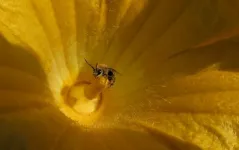(Press-News.org) An insecticide used to control pest infestations on squash and pumpkins significantly hinders the reproduction of ground-nesting bees -- valuable pollinators for many food crops, a new University of Guelph study has revealed.
This first-ever study of pesticide impacts on a ground-nesting bee in a real-world context found female hoary squash bees exposed to imidacloprid dug 85 per cent fewer nests, collected less pollen from crop flowers and produced 89 per cent fewer offspring than unexposed bees.
"Because they're not making nests and not collecting pollen, they cannot raise offspring," said Dr. Susan Willis Chan, a post-doc in the School of Environmental Sciences (SES), who conducted the study with Dr. Nigel Raine, holder of the Rebanks Family Chair in Pollinator Conservation in SES. "That means imidacloprid-exposed populations are going to decline."
Neonicotinoids (or neonics) are neurotoxic insecticides that kill insects by attacking their nervous systems, affecting learning, foraging and navigation in many kinds of bees. Farmers use the neonic imidacloprid to control cucumber beetles, the most damaging crop pest for squash and pumpkins.
Many species of ground-nesting bees, including the hoary squash bee, are responsible for pollination of numerous fruits, vegetables and oilseed crops in North America, said Chan.
"Solitary ground-nesting bees make up about 70 per cent of bee species. It's a really important ecological group and is also really important in crop pollination," she said.
However, these ground-dwellers are often overlooked when it comes to evaluating the impacts of pesticides on pollinators, she added.
Published recently in Scientific Reports , the study involved three years of monitoring the foraging and nesting behaviour of squash bees.
To mimic field conditions, Chan held the bees in mesh-covered enclosures that still allowed exposure to sun and rain and other environmental factors. She applied pesticides in ways that mirror actual use in farmers' fields.
Chan tested three insecticide treatments: the neonic imidacloprid applied to soil at planting time; the neonic thiamethoxam applied as a seed treatment; and an anthranilic diamide (an emerging non-neonic insecticide) sprayed onto growing plants. A fourth group without insecticides served as a control.
Studying the bees for three years allowed the team to show longer-term impacts of imidacloprid exposure on reduced nest-building, foraging and offspring reduction.
Bees visiting squash plants treated with anthranilic diamide collected significantly less pollen than those in the control group but had no fewer nests or offspring. Chan saw no measurable effects from the thiamethoxam seed treatment on pollen harvesting, nest construction or offspring production.
"Farmers and regulators need to look at alternatives to applying imidacloprid to soil for controlling pests on squash and pumpkins," she said.
"My recommendation to pumpkin and squash farmers is to stay away from imidacloprid applied to soil to keep their squash bees healthy."
Raine said it's likely other solitary, ground-nesting species are also being affected.
Noting that other ground-nesters live in farm fields, he said, "The sort of impacts from soil-applied pesticide exposure we've seen in this study could affect many other species of wild bees."
He said current regulatory assessments for insect pollinators fail to consider risks associated with soil pesticide residues. "Our results highlight why this should be changed to better characterize risk for the many bee species that spend a large proportion of their life in soil."
Given the importance of pollinating insects to crop production, Chan said, "Farmers need to protect their crops from pests, but they also absolutely need to protect pollinators from the unintended effects of pesticides."
Referring to imidacloprid, she said, "The data on this particular product are so clear that there's really no question about what has to happen. We have to find something else."
INFORMATION:
This research was funded by the Ontario Ministry of Agriculture, Food and Rural Affairs; the Ontario Ministry of the Environment, Conservation and Parks; the Ontario Fresh Vegetable Growers' Association; the Natural Sciences and Engineering Research Council; and the Weston Family Foundation.
Heart problems cause disturbed gene activity in the brain's memory center, from which cognitive deficits arise. Researchers at the German Center for Neurodegenerative Diseases (DZNE), the University Medical Center Göttingen (UMG) and the German Center for Cardiovascular Research (DZHK) come to this conclusion based on laboratory studies. They consider that they have found a possible cause for the increased risk of dementia in people with heart problems. In mice, a specific drug which is known to affect gene activity alleviated the mental deficits. The involved experts see these results as potential approaches for therapies. ...
HOUSTON - (Feb. 26, 2021) - Tracking the origin of synthetic genetic code has never been simple, but it can be done through bioinformatic or, increasingly, deep learning computational approaches.
Though the latter gets the lion's share of attention, new research by computer scientist Todd Treangen of Rice University's Brown School of Engineering is focused on whether sequence alignment and pan-genome-based methods can outperform recent deep learning approaches in this area.
"This is, in a sense, against the grain given that deep learning approaches have recently outperformed traditional approaches, such as BLAST," he said. "My goal with this study is to start a conversation about how to combine the expertise of both domains to achieve further improvements for this important computational ...
TORONTO, Feb. 26, 2021 - The maternal care of offspring is one of the behavioural drivers that has led some bee species to have an ever-expanding social life over the history of evolution, new research out of York University has found.
By virtue of being in a social group, the genome itself may respond by selecting more social rather than non-social genes. The behaviour and social environment come first, setting the stage for future molecular evolution.
In addition, the researchers have found that a similar genetic evolution happened independently in different species at different times, suggesting there is a unifying principle leading to the same social trait.
"There seems to be something about sociality specifically that is driving the genome to evolve in this way. It's a very ...
COLUMBIA, Mo. -- Marilyn Rantz still remembers the day she got the call that her mother, whose health had been declining, had fallen and fractured her shoulder. After rushing to the hospital, her mother told her she didn't understand how she ended up on a helicopter pad after the traumatic incident. A nearby nurse told Rantz the noise from the MRI scanning tube had caused her frightened mother to mistakenly believe she had been airlifted to the hospital on a helicopter.
Determined to prevent avoidable hospitalizations, as well as the stress and panic that often comes along with the ambulance ride, Rantz, ...
MEMPHIS, Tenn. - Extremely low birth weight (ELBW) infants with moderate to large patent ductus arteriosus (PDA) may benefit from transcatheter PDA closure (TCPC) in the first four weeks of life, according to research published by Le Bonheur Cardiologist Ranjit Philip, MD, and Medical Director of Interventional Cardiac Imaging and Interventional Catheterization Laboratory Shyam Sathanandam, MD. Early PDA closure may prevent early onset pulmonary vascular disease, promote growth and facilitate faster weaning off supplemental oxygen and ventilator support.
"The primary objective of this study was to describe changes in hemodynamics, ...
The National Cancer Institute's Genomic Data Commons (GDC), launched in 2016 by then-Vice President Joseph Biden and hosted at the University of Chicago, has become one of the largest and most widely used resources in cancer genomics, with more than 3.3 petabytes of data from more than 65 projects and over 84,000 anonymized patient cases, serving more than 50,000 unique users each month.
In new papers published Feb. 22 in Nature Communications and Nature Genetics, the UChicago-based research team shares new details about the GDC, which is funded by the National Cancer Institute (NCI), via subcontract with the Frederick National Laboratory for Cancer Research, currently operated by ...
Climate alone is not a driver for human behavior. The choices that people make in the face of changing conditions take place in a larger human context. And studies that combine insights from archaeologists and environmental scientists can offer more nuanced lessons about how people have responded -- sometimes successfully -- to long-term environmental changes.
One such study, from researchers at Washington University in St. Louis and the Chinese Academy of Sciences, shows that aridification in the central plains of China during the early Bronze Age did not cause population collapse, a result that highlights the importance of social ...
URBANA, Ill. - Economists and urban planners generally agree that local pollution sources disproportionally impact racial minorities in the U.S. The reasons for this are largely unclear, but a University of Illinois study provides new insights into the issue.
"Our work finds experimental evidence that racial discrimination in the home-renting process actively sorts minority renters into neighborhoods with higher levels of pollution," says Peter Christensen, assistant professor in the Department of Agricultural and Consumer Economics (ACE) and an affiliate in Center for the Economics of Sustainability at University of Illinois.
Christensen and co-authors Ignacio Sarmiento-Barbieri, U of I, and Christopher Timmins of Duke University conducted an empirical ...
Challenging the idea that older people with shorter life expectancies should rank lower in coronavirus immunization efforts, new UC Berkeley research shows that giving vaccine priority to those most at risk of dying from COVID-19 will save the maximum number of lives, and their potential or future years of life.
The findings, published Feb. 25 in the journal Proceedings of the National Academy of Sciences, address the ethical dilemma of who should be first in line for a limited supply of vaccine shots amid a contagion that so far has killed 500,000 in the United States and 2.4 million globally.
"Since older age is accompanied by falling life expectancy, it is widely assumed that means we're saving fewer years of life," said study lead author Joshua Goldstein, a UC Berkeley ...
Scientists at UCL and the IIT -Istituto Italiano di Tecnologia (Italian Institute of Technology) have created a temporary tattoo with light-emitting technology used in TV and smartphone screens, paving the way for a new type of "smart tattoo" with a range of potential uses.
The technology, which uses organic light-emitting diodes (OLEDs), is applied in the same way as water transfer tattoos. That is, the OLEDs are fabricated on to temporary tattoo paper and transferred to a new surface by being pressed on to it and dabbed with water.
The researchers, who ...




